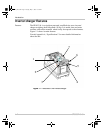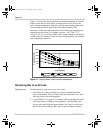
Planning for AC Loads
975-0337-01-01 2–3
DC loads
DC loads are those that run off a 12 volt electrical system. A few
examples of DC loads are:
• marker lights, headlights, vehicle lighting, other lights using DC
power
• DC refrigerators
• VHF radios
• factory-installed radios or sound systems
• pumps, lights, fans, power vents, LPG leak detector, toilet, and some
water heaters.
DC loads and the inverter
/charger both rely on the batteries for power.
Many DC loads running at one time will shorten the operating times of
AC loads.
Problem loads
Problem loads are loads you should not operate from the inverter/charger
because they may be damaged or may not operate properly:
• dimmer switches
• some small rechargeable hand-power tools
• small battery-operated appliances such as flashlights, razors, night
lights
• variable speed motors
Ambient Temperature
Ambient
temperature
The ambient temperature, that is, the air temperature around the inverter/
charger, will affect its output power.
Ambient temperature can rise when the vehicle is exposed to hot weather
conditions or cabin heat from heaters.
Temperature
and power
Generally, the output power decreases as the temperature increases. For
example, at 77 °F (25 °C) the unit delivers 1000 watts for as long as you
have sufficient battery power. At 104 °F (40 °C) it delivers 1000 watts for
up to 30 minutes before shutting down, 2000 watts for 2 minutes, or 750
watts continuous.
IP1012_AL.book Page 3 Tuesday, May 1, 2007 12:18 PM


















